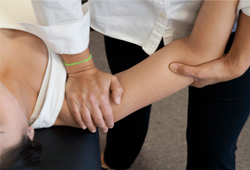Shoulder Injury Physical Therapy
The Shoulder Joint
 The shoulder joint is actually a complex consisting of four different joints. The shoulder has the most range of motion, moving from 0 degrees to 180 degrees of overhead motion. What accompanies this extensive range of motion is an inherent instability secondary to the nature of the structure of the joint to attain this large range of motion.
The shoulder joint is actually a complex consisting of four different joints. The shoulder has the most range of motion, moving from 0 degrees to 180 degrees of overhead motion. What accompanies this extensive range of motion is an inherent instability secondary to the nature of the structure of the joint to attain this large range of motion.
Function of the Shoulder Joint
The function of the shoulder joint is to place the hand in space. It’s only connection to the torso is via the clavicle, or collarbone and the acromion, a bony protrusion of the scapula, or shoulder blade. The primary joint is called the glenohumeral joint and is what everyone refers to as the shoulder. It is the direct bony connection of the humerus, or upper bone of the arm and the glenoid cavity, or lateral (side) surface of the scapula.
After injury, the GH joint has a tendency to migrate forward and upward secondary to the patient holding the arm in against the torso. This position limits motion of the GH joint, thereby reducing any pain when using the arm. It is the position that the arm is placed in if in a sling.
The technique demonstrated is an anterior-posterior GH joint mobilization. The function of this mobilization is to push the humerus back in the glenoid cavity to increase pain-free motion during arm elevation.
Frozen Shoulder
Frozen shoulder, or Adhesive Capsulitis is a condition in the shoulder where your joint stiffens up so significantly that it ‘freezes’ or gets stuck. The condition is caused by trauma, chronic inflammation or of insidious onset (unknown cause). It is marked by 3 phases: freezing, frozen and thawing stage.
Read more about Frozen Shoulder >
Shoulder Tendonitis
Tendonitis is an overuse, repetitive stress type of injury. It is an inflammation and irritation to the tendon which is overused during activities. The tendon is the attachment from the muscle to the bone and it is through this and the muscle tissue that movement occurs.
Common tendonitis areas are found in the shoulder, elbow, wrist, knee and ankle. The condition can become painful from repetitive use and movement, and easily become chronic because we move our bodies all day. Click here to read more about Tendonitis >.
Physical Therapy for the Shoulder: Our Approach
- The patient is lying on her back.
- The therapist stands at the side of the restricted shoulder joint, facing the head of the patient.
- Using the palm of the hand, with emphasis on the pinky finger side, the hand is placed on the humeral head with the arm straight. This is the mobilizing hand.
- The other hand grasps the patient’s elbow and pulls the arm slightly out sideways at shoulder height (traction).
- The mobilizing hand applies a downward force toward the floor using the body weight of the therapist.


